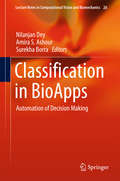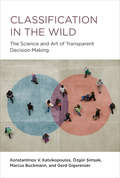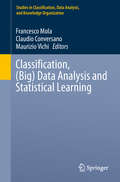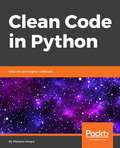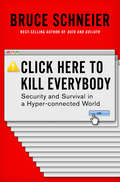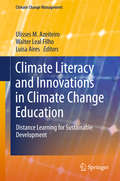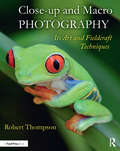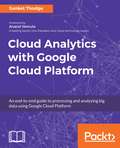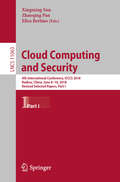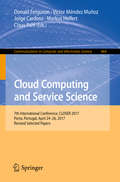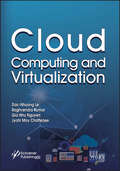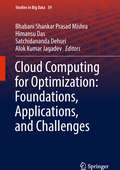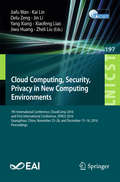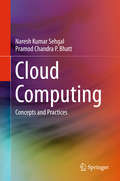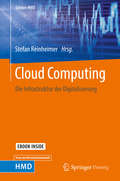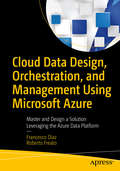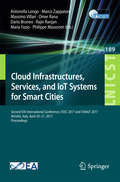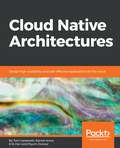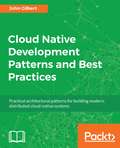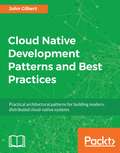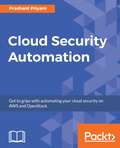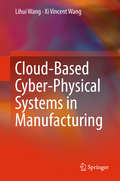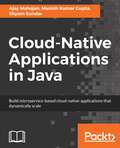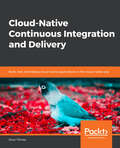- Table View
- List View
Classification in BioApps: Automation of Decision Making (Lecture Notes in Computational Vision and Biomechanics #26)
by Nilanjan Dey Amira S. Ashour Surekha BorraThis book on classification in biomedical image applications presents original and valuable research work on advances in this field, which covers the taxonomy of both supervised and unsupervised models, standards, algorithms, applications and challenges. Further, the book highlights recent scientific research on artificial neural networks in biomedical applications, addressing the fundamentals of artificial neural networks, support vector machines and other advanced classifiers, as well as their design and optimization. In addition to exploring recent endeavours in the multidisciplinary domain of sensors, the book introduces readers to basic definitions and features, signal filters and processing, biomedical sensors and automation of biomeasurement systems. The target audience includes researchers and students at engineering and medical schools, researchers and engineers in the biomedical industry, medical doctors and healthcare professionals.
Classification in the Wild: The Science and Art of Transparent Decision Making
by Gerd Gigerenzer Konstantinos V. Katsikopoulos Ozgur Simsek Marcus BuckmannRules for building formal models that use fast-and-frugal heuristics, extending the psychological study of classification to the real world of uncertainty.This book focuses on classification--allocating objects into categories--"in the wild," in real-world situations and far from the certainty of the lab. In the wild, unlike in typical psychological experiments, the future is not knowable and uncertainty cannot be meaningfully reduced to probability. Connecting the science of heuristics with machine learning, the book shows how to create formal models using classification rules that are simple, fast, and transparent and that can be as accurate as mathematically sophisticated algorithms developed for machine learning.
Classification, (Studies In Classification, Data Analysis, And Knowledge Organization Ser.)
by Maurizio Vichi Francesco Mola Claudio ConversanoThis edited book focuses on the latest developments in classification, statistical learning, data analysis and related areas of data science, including statistical analysis of large datasets, big data analytics, time series clustering, integration of data from different sources, as well as social networks. It covers both methodological aspects as well as applications to a wide range of areas such as economics, marketing, education, social sciences, medicine, environmental sciences and the pharmaceutical industry. In addition, it describes the basic features of the software behind the data analysis results, and provides links to the corresponding codes and data sets where necessary. This book is intended for researchers and practitioners who are interested in the latest developments and applications in the field. The peer-reviewed contributions were presented at the 10th Scientific Meeting of the Classification and Data Analysis Group (CLADAG) of the Italian Statistical Society, held in Santa Margherita di Pula (Cagliari), Italy, October 8–10, 2015.
Clean Code in Python: Refactor your legacy code base
by Mariano AnayaGetting the most out of Python to improve your codebaseKey FeaturesSave maintenance costs by learning to fix your legacy codebaseLearn the principles and techniques of refactoringApply microservices to your legacy systems by implementing practical techniquesBook DescriptionPython is currently used in many different areas such as software construction, systems administration, and data processing. In all of these areas, experienced professionals can find examples of inefficiency, problems, and other perils, as a result of bad code. After reading this book, readers will understand these problems, and more importantly, how to correct them. The book begins by describing the basic elements of writing clean code and how it plays an important role in Python programming. You will learn about writing efficient and readable code using the Python standard library and best practices for software design. You will learn to implement the SOLID principles in Python and use decorators to improve your code. The book delves more deeply into object oriented programming in Python and shows you how to use objects with descriptors and generators. It will also show you the design principles of software testing and how to resolve software problems by implementing design patterns in your code. In the final chapter we break down a monolithic application to a microservice one, starting from the code as the basis for a solid platform. By the end of the book, you will be proficient in applying industry approved coding practices to design clean, sustainable and readable Python code. What you will learnSet up tools to effectively work in a development environmentExplore how the magic methods of Python can help us write better codeExamine the traits of Python to create advanced object-oriented designUnderstand removal of duplicated code using decorators and descriptorsEffectively refactor code with the help of unit testsLearn to implement the SOLID principles in PythonWho this book is forThis book will appeal to team leads, software architects and senior software engineers who would like to work on their legacy systems to save cost and improve efficiency. A strong understanding of Programming is assumed.
Click Here to Kill Everybody: Security And Survival In A Hyper-connected World
by Bruce SchneierA world of "smart" devices means the Internet can kill people. We need to act. Now. Everything is a computer. Ovens are computers that make things hot; refrigerators are computers that keep things cold. These computers—from home thermostats to chemical plants—are all online. The Internet, once a virtual abstraction, can now sense and touch the physical world. As we open our lives to this future, often called the Internet of Things, we are beginning to see its enormous potential in ideas like driverless cars, smart cities, and personal agents equipped with their own behavioral algorithms. But every knife cuts two ways. All computers can be hacked. And Internet-connected computers are the most vulnerable. Forget data theft: cutting-edge digital attackers can now crash your car, your pacemaker, and the nation’s power grid. In Click Here to Kill Everybody, renowned expert and best-selling author Bruce Schneier examines the hidden risks of this new reality. After exploring the full implications of a world populated by hyperconnected devices, Schneier reveals the hidden web of technical, political, and market forces that underpin the pervasive insecurities of today. He then offers common-sense choices for companies, governments, and individuals that can allow us to enjoy the benefits of this omnipotent age without falling prey to its vulnerabilities. From principles for a more resilient Internet of Things, to a recipe for sane government regulation and oversight, to a better way to understand a truly new environment, Schneier’s vision is required reading for anyone invested in human flourishing.
Climate Literacy and Innovations in Climate Change Education: Distance Learning for Sustainable Development (Climate Change Management)
by Walter Leal Filho Ulisses M. Azeiteiro Luísa AiresThis book addresses the links between climate change and the threats it poses to sustainable development, from a distance education perspective. Discussing current trends and challenges in sustainable development education, climate literacy and innovations in climate change education, it contributes to the global debate on the implementation of education for sustainability. It also assesses the role that e-learning can play in this process, addressing pedagogical concepts as well as the wide range of technological options now available.
Close-up and Macro Photography: Its Art and Fieldcraft Techniques
by Robert ThompsonFocusing on fieldcraft techniques for macro and close-up photography, Thompson covers the vital but often overlooked skills necessary to achieve consistent professional results in the field. Case studies covering a broad and often challenging group of subjects from the seashore to your back garden form the core of the lavishly illustrated book. Biology, life history, subject behaviour and ethics along with best practice approaches are discussed in detail and underpinned with photographic tips. The book is divided into four sections—Digital Fundamentals, Fieldcraft & Methodology, Portfolio Case Studies, Digital Workflow & Presentation—covering the full photographic process from capture through to editing, captioning, development and storage are discussed. Moving beyond the surface-level approach to macro instruction, this book provides readers with techniques that work in the field. Illustrated with over 250 of the author's own inspiring images, this publication is a must for photographers, naturalists and anyone interested in improving their macro skills in the field.
Cloud Analytics with Google Cloud Platform: An end-to-end guide to processing and analyzing big data using Google Cloud Platform
by Sanket ThodgeCombine the power of analytics and cloud computing for faster and efficient insightsKey FeaturesMaster the concept of analytics on the cloud: and how organizations are using itLearn the design considerations and while applying a cloud analytics solutionDesign an end-to-end analytics pipeline on the cloudBook DescriptionWith the ongoing data explosion, more and more organizations all over the world are slowly migrating their infrastructure to the cloud. These cloud platforms also provide their distinct analytics services to help you get faster insights from your data. This book will give you an introduction to the concept of analytics on the cloud, and the different cloud services popularly used for processing and analyzing data. If you’re planning to adopt the cloud analytics model for your business, this book will help you understand the design and business considerations to be kept in mind, and choose the best tools and alternatives for analytics, based on your requirements. The chapters in this book will take you through the 70+ services available in Google Cloud Platform and their implementation for practical purposes. From ingestion to processing your data, this book contains best practices on building an end-to-end analytics pipeline on the cloud by leveraging popular concepts such as machine learning and deep learning.By the end of this book, you will have a better understanding of cloud analytics as a concept as well as a practical know-how of its implementationWhat you will learn Explore the basics of cloud analytics and the major cloud solutions Learn how organizations are using cloud analytics to improve the ROI Explore the design considerations while adopting cloud services Work with the ingestion and storage tools of GCP such as Cloud Pub/Sub Process your data with tools such as Cloud Dataproc, BigQuery, etcOver 70 GCP tools to build an analytics engine for cloud analytics Implement machine learning and other AI techniques on GCP Who this book is forThis book is targeted at CIOs, CTOs, and even analytics professionals looking for various alternatives to implement their analytics pipeline on the cloud. Data professionals looking to get started with cloud-based analytics will also find this book useful. Some basic exposure to cloud platforms such as GCP will be helpful, but not mandatory.
Cloud Computing and Security: 4th International Conference, ICCCS 2018, Haikou, China, June 8-10, 2018, Revised Selected Papers, Part I (Lecture Notes in Computer Science #11063)
by Elisa Bertino Xingming Sun Zhaoqing PanThis six volume set LNCS 11063 – 11068 constitutes the thoroughly refereed conference proceedings of the 4th International Conference on Cloud Computing and Security, ICCCS 2018, held in Haikou, China, in June 2018. The 386 full papers of these six volumes were carefully reviewed and selected from 1743 submissions. The papers cover ideas and achievements in the theory and practice of all areas of inventive systems which includes control, artificial intelligence, automation systems, computing systems, electrical and informative systems. The six volumes are arranged according to the subject areas as follows: cloud computing, cloud security, encryption, information hiding, IoT security, multimedia forensics.
Cloud Computing and Service Science: 7th International Conference, CLOSER 2017, Porto, Portugal, April 24–26, 2017, Revised Selected Papers (Communications in Computer and Information Science #864)
by Markus Helfert Donald Ferguson Jorge Cardoso Víctor Méndez Muñoz Claus PahlThis book constitutes extended, revised and selected papers from the 7th Ith International Conference on Cloud Computing and Service Science, CLOSER 2017, held in Porto, Portugal, in April 2017. The 16 papers presented in this volume were carefully reviewed and selected from a total of 123 submissions. CLOSER 2017 focused on the emerging area of Cloud Computing, inspired by some latest advances that concern the infrastructure, operations and available services throughout the global network.
Cloud Computing and Virtualization
by Dac-Nhuong Le Raghvendra Kumar Nguyen Gia Nhu Jyotir Moy ChatterjeeThe purpose of this book is first to study cloud computing concepts, security concern in clouds and data centers, live migration and its importance for cloud computing, the role of firewalls in domains with particular focus on virtual machine (VM) migration and its security concerns. The book then tackles design, implementation of the frameworks and prepares test-beds for testing and evaluating VM migration procedures as well as firewall rule migration. The book demonstrates how cloud computing can produce an effective way of network management, especially from a security perspective.
Cloud Computing for Optimization: Foundations, Applications, and Challenges (Studies in Big Data #39)
by Bhabani Shankar Prasad Mishra Satchidananda Dehuri Alok Kumar Jagadev Himansu DasThis book discusses harnessing the real power of cloud computing in optimization problems, presenting state-of-the-art computing paradigms, advances in applications, and challenges concerning both the theories and applications of cloud computing in optimization with a focus on diverse fields like the Internet of Things, fog-assisted cloud computing, and big data. In real life, many problems – ranging from social science to engineering sciences – can be identified as complex optimization problems. Very often these are intractable, and as a result researchers from industry as well as the academic community are concentrating their efforts on developing methods of addressing them. Further, the cloud computing paradigm plays a vital role in many areas of interest, like resource allocation, scheduling, energy management, virtualization, and security, and these areas are intertwined with many optimization problems. Using illustrations and figures, this book offers students and researchers a clear overview of the concepts and practices of cloud computing and its use in numerous complex optimization problems.
Cloud Computing – CLOUD 2018: 11th International Conference, Held as Part of the Services Conference Federation, SCF 2018, Seattle, WA, USA, June 25–30, 2018, Proceedings (Lecture Notes in Computer Science #10967)
by Liang-Jie Zhang Min LuoThis volume constitutes the proceedings of the 11th International Conference on Cloud Computing, CLOUD 2018, held as part of the Services Conference Federation, SCF 2018, in Seattle, WA, USA, in June 2018.The 26 full papers presented together with 3 short papers were carefully reviewed and selected from 108 submissions. They are organized in topical sections such as cloud computing; client-server architectures; distributed systems organizing principles; storage virtualization; virtual machines; cloud based storage; distributed architectures; network services; and computing platforms.
Cloud Computing, Security, Privacy in New Computing Environments: 7th International Conference, CloudComp 2016, and First International Conference, SPNCE 2016, Guangzhou, China, November 25–26, and December 15–16, 2016, Proceedings (Lecture Notes of the Institute for Computer Sciences, Social Informatics and Telecommunications Engineering #197)
by Jin Li Yang Xiang Jiafu Wan Kai Lin Delu Zeng Xiaofeng Liao Jiwu Huang Zheli LiuThis book constitutes the refereed proceedings of the 7th International Conference on Cloud Computing, Security, Privacy in New Computing Environments, CloudComp 2016, and the First EAI International Conference SPNCE 2016, both held in Guangzhou, China, in November and December 2016. The proceedings contain 10 full papers selected from 27 submissions and presented at CloudComp 2016 and 12 full papers selected from 69 submissions and presented at SPNCE 2016. CloudComp 2016 presents recent advances and experiences in clouds, cloud computing and related ecosystems and business support. SPNCE 2016 focuses on security and privacy aspects of new computing environments including mobile computing, big data, cloud computing and other large-scale environments.
Cloud Computing: Concepts And Practices
by Naresh Kumar Sehgal Pramod Chandra P. BhattThis book provides readers with an overview of Cloud Computing, starting with historical background on mainframe computers and early networking protocols, leading to current concerns such as hardware and systems security, performance, emerging areas of IoT, Edge Computing etc. Readers will benefit from the in-depth discussion of cloud computing usage and the underlying architecture, with focus on best practices for using a dynamic cloud infrastructure, cloud operations management and cloud security. The authors explain carefully the “why’s and how’s” of Cloud Computing, so engineers will find this book and invaluable introduction to the topic.
Cloud Computing: Die Infrastruktur Der Digitalisierung (Edition HMD)
by Stefan ReinheimerDas Herausgeberwerk zeigt Chancen und Risiken des Cloud Computings auf, bringt Lesern das Thema durch anschauliche Beispiele aus Forschung und Praxis näher und zeigt die Implikationen auf, die aus dieser neuen Infrastruktur resultieren. Die Beitragsautoren präsentieren technische Lösungen, Geschäftsmodelle und Visionen, die einerseits die Herausforderungen und Hürden des Cloud Computing aufgreifen – technisch, rechtlich, prozessbezogen – und andererseits die Chancen und Nutzen dieses Architekturansatzes in den Mittelpunkt stellen. Es ist zeitgemäß, IT-Infrastrukturen, Daten und Applikationen aus der lokalen Umgebung in eine Cloud auszulagern. Der Anwender kann sich der angebotenen IT-Dienstleistungen unter Nutzung von Self-Service-Ansätzen bedienen, in Abhängigkeit davon, was und wieviel er gerade benötigt – und auch nur dafür wird gezahlt. Bereitgestellt, gewartet und aktualisiert werden die IT-Ressourcen zentral. Je nach Art der IT-Dienstleistung, die über die Cloud bereitgestellt werden, unterscheidet man zwischen IaaS – Infrastructure as a Service, PaaS – Platform as a Service und SaaS – Software as a Service. Der Sicherheitsbedarf und die Leistungsfähigkeit der Unternehmens-IT entscheiden darüber, ob man diesen Zentralisierungsansatz unternehmensintern in einer Private Cloud oder unternehmensextern in einer Public Cloud umsetzt. Sogenannte Hybrid Clouds sind ein Mittelweg, der sich immer stärker etabliert. Das Buch richtet sich an alle, die sich umfassend und praxisnah zum Thema Cloud Computing informieren möchten und die nach einer modernen Infrastruktur für die Umsetzung von Digitalisierungsansätzen suchen.
Cloud Data Design, Orchestration, and Management Using Microsoft Azure: Master and Design a Solution Leveraging the Azure Data Platform
by Roberto Freato Francesco DiazUse Microsoft Azure to optimally design your data solutions and save time and money. Scenarios are presented covering analysis, design, integration, monitoring, and derivatives.This book is about data and provides you with a wide range of possibilities to implement a data solution on Azure, from hybrid cloud to PaaS services. Migration from existing solutions is presented in detail. Alternatives and their scope are discussed. Five of six chapters explore PaaS, while one focuses on SQL Server features for cloud and relates to hybrid cloud and IaaS functionalities.What You'll LearnKnow the Azure services useful to implement a data solutionMatch the products/services used to your specific needsFit relational databases efficiently into data designUnderstand how to work with any type of data using Azure hybrid and public cloud featuresUse non-relational alternatives to solve even complex requirementsOrchestrate data movement using Azure servicesApproach analysis and manipulation according to the data life cycleWho This Book Is ForSoftware developers and professionals with a good data design background and basic development skills who want to learn how to implement a solution using Azure data services
Cloud Infrastructures, Services, and IoT Systems for Smart Cities: Second EAI International Conference, IISSC 2017 and CN4IoT 2017, Brindisi, Italy, April 20–21, 2017, Proceedings (Lecture Notes of the Institute for Computer Sciences, Social Informatics and Telecommunications Engineering #189)
by Dario Bruneo Omer Rana Maria Fazio Antonella Longo Marco Zappatore Massimo Villari Rajiv Ranjan Philippe MassonetThis book constitutes the proceedings of the Second International Conference on Cloud, Networking for IoT Systems, CN4IoT 2017, and the Second EAI International Conference on ICT Infrastructures and Services for Smart Cities, IISSC 2017, held in Brindisi, Italy, in April 2017. The 26 full papers of both conferences were selected from 39 submissions. CN4IoT presents research activities on the uniform management and operation related to software defined infrastructures, in particular by analyzing limits or advantages in solutions for Cloud Networking and IoT. IISSC papers focus on ICT infrastructures (technologies, models, frameworks) and services in cities and smart communities.
Cloud Native Architectures: Design high-availability and cost-effective applications for the cloud
by Tom Laszewski Kamal Arora Erik Farr Piyum ZonoozLearn and understand the need to architect cloud applications and migrate your business to cloud efficientlyKey FeaturesUnderstand the core design elements required to build scalable systemsPlan resources and technology stacks effectively for high security and fault toleranceExplore core architectural principles using real-world examplesBook DescriptionCloud computing has proven to be the most revolutionary IT development since virtualization. Cloud native architectures give you the benefit of more flexibility over legacy systems. To harness this, businesses need to refresh their development models and architectures when they find they don’t port to the cloud. Cloud Native Architectures demonstrates three essential components of deploying modern cloud native architectures: organizational transformation, deployment modernization, and cloud native architecture patterns.This book starts with a quick introduction to cloud native architectures that are used as a base to define and explain what cloud native architecture is and is not. You will learn what a cloud adoption framework looks like and develop cloud native architectures using microservices and serverless computing as design principles. You’ll then explore the major pillars of cloud native design including scalability, cost optimization, security, and ways to achieve operational excellence. In the concluding chapters, you will also learn about various public cloud architectures ranging from AWS and Azure to the Google Cloud Platform.By the end of this book, you will have learned the techniques to adopt cloud native architectures that meet your business requirements. You will also understand the future trends and expectations of cloud providers.What you will learnLearn the difference between cloud native and traditional architectureExplore the aspects of migration, when and why to use itIdentify the elements to consider when selecting a technology for your architectureAutomate security controls and configuration managementUse infrastructure as code and CICD pipelines to run environments in a sustainable mannerUnderstand the management and monitoring capabilities for AWS cloud native application architecturesWho this book is forCloud Native Architectures is for software architects who are keen on designing resilient, scalable, and highly available applications that are native to the cloud.
Cloud Native Development Patterns and Best Practices: Practical Architectural Patterns For Building Modern, Distributed Cloud-native Systems
by John Gilbert<P><P>Learn to apply cloud-native patterns and practices to deliver responsive, resilient, elastic, and message-driven systems with confidence <P><P>Key Features <P><P>Understand the architectural patterns involved in cloud-native architectures <P><P>Minimize risk by evolving your monolithic applications into distributed cloud-native systems <P><P>Discover best practices for applying cloud-native patterns to your enterprise-level cloud applications <P><P>Book Description <P><P>Build systems that leverage the benefits of the cloud and applications faster than ever before with cloud-native development. This book focuses on architectural patterns for building highly scalable cloud-native systems. You will learn how the combination of cloud, reactive principles, devops, and automation enable teams to continuously deliver innovation with confidence. <P><P>Begin by learning the core concepts that make these systems unique. You will explore foundational patterns that turn your database inside out to achieve massive scalability with cloud-native databases. You will also learn how to continuously deliver production code with confidence by shifting deployment and testing all the way to the left and implementing continuous observability in production. There's more-you will also learn how to strangle your monolith and design an evolving cloud-native system. <P><P>By the end of the book, you will have the ability to create modern cloud-native systems. <P><P>What you will learn <P><P>Enable massive scaling by turning your database inside out <P><P>Unleash flexibility via event streaming <P><P>Leverage polyglot persistence and cloud-native databases <P><P>Embrace modern continuous delivery and testing techniques <P><P>Minimize risk by evolving your monoliths to cloud-native <P><P>Apply cloud-native patterns and solve major architectural problems in cloud environment <P><P>Who This Book Is For <P><P>This book is for developers who would like to progress into building cloud-native systems and are keen to learn the patterns involved. Basic knowledge of programming and cloud computing is required.
Cloud Native Development Patterns and Best Practices: Practical architectural patterns for building modern, distributed cloud-native systems
by John GilbertLearn to apply cloud-native patterns and practices to deliver responsive, resilient, elastic, and message-driven systems with confidence Key Features Understand the architectural patterns involved in cloud-native architectures Minimize risk by evolving your monolithic applications into distributed cloud-native systems Discover best practices for applying cloud-native patterns to your enterprise-level cloud applications Book Description Build systems that leverage the benefits of the cloud and applications faster than ever before with cloud-native development. This book focuses on architectural patterns for building highly scalable cloud-native systems. You will learn how the combination of cloud, reactive principles, devops, and automation enable teams to continuously deliver innovation with confidence. Begin by learning the core concepts that make these systems unique. You will explore foundational patterns that turn your database inside out to achieve massive scalability with cloud-native databases. You will also learn how to continuously deliver production code with confidence by shifting deployment and testing all the way to the left and implementing continuous observability in production. There's more—you will also learn how to strangle your monolith and design an evolving cloud-native system. By the end of the book, you will have the ability to create modern cloud-native systems. What you will learn Enable massive scaling by turning your database inside out Unleash flexibility via event streaming Leverage polyglot persistence and cloud-native databases Embrace modern continuous delivery and testing techniques Minimize risk by evolving your monoliths to cloud-native Apply cloud-native patterns and solve major architectural problems in cloud environment Who this book is for This book is for developers who would like to progress into building cloud-native systems and are keen to learn the patterns involved. Basic knowledge of programming and cloud computing is required.
Cloud Security Automation: Get to grips with automating your cloud security on AWS and OpenStack
by Prashant PriyamSecure public and private cloud workloads with this comprehensive learning guide.Key Features Take your cloud security functions to the next level by automation Learn to automate your security functions on AWS and OpenStack Practical approach towards securing your workloads efficientlyBook DescriptionSecurity issues are still a major concern forall IT organizations. For many enterprises,the move to cloud computing has raisedconcerns for security, but when applicationsare architected with focus on security,cloud platforms can be made just as secureas on-premises platforms. Cloud instancescan be kept secure by employing securityautomation that helps make your data meetyour organization's security policy.This book starts with the basics of whycloud security is important and howautomation can be the most effective wayof controlling cloud security. You willthen delve deeper into the AWS cloudenvironment and its security servicesby dealing with security functions suchas Identity and Access Managementand will also learn how these servicescan be automated. Moving forward,you will come across aspects suchas cloud storage and data security, automatingcloud deployments, and so on. Then,you'll work with OpenStack security modulesand learn how private cloud securityfunctions can be automated for bettertime- and cost-effectiveness. Toward the endof the book, you will gain an understandingof the security compliance requirementsfor your Cloud.By the end of this book, you will havehands-on experience of automating yourcloud security and governance.What you will learn Define security for public and privatecloud services Address the security concerns ofyour cloud Understand Identity and AccessManagement Get acquainted with cloud storageand network security Improve and optimize publicand private cloud security Automate cloud security Understand the security compliancerequirements of your cloudWho this book is forThis book is targeted at DevOps Engineers, Security professionals, or any stakeholders responsible for securing cloud workloads. Prior experience with AWS or OpenStack will be an advantage.
Cloud-Based Cyber-Physical Systems in Manufacturing
by Lihui Wang Xi Vincent WangThis book presents state-of-the-art research, challenges and solutions in the area of cloud-based cyber-physical systems (CPS) used in manufacturing. It provides a comprehensive review of the literature and an in-depth treatment of novel methodologies, algorithms and systems in the area of architecture design, cyber security, process planning, monitoring and control. The book features detailed descriptions of how to derive solutions in a cloud environment where physical machines can be supported by cyber decision systems when engaged in real operations. It presents a range of novel ideas and is characterized by a balanced approach in terms of scope vs. depth and theory vs. applications. It also takes into account the need to present intellectual challenges while appealing to a broad readership, including academic researchers, practicing engineers and managers, and graduate students. Dedicated to the topic of cloud-based CPS and its practical applications in manufacturing, this book benefits readers from all manufacturing sectors, from system design to lifecycle engineering and from process planning to machine control. It also helps readers to understand the present challenges and future research directions towards factories of the future, helping them to position themselves strategically for career development.
Cloud-Native Applications in Java: Build microservice-based cloud-native applications that dynamically scale
by Shyam Sundar Ajay Mahajan Munish Kumar GuptaHighly available microservice-based web apps for Cloud with Java Key Features Take advantage of the simplicity of Spring to build a full-fledged application Let your applications run faster while generating smaller cloud service bills Integrate your application with various tools such as Docker and ElasticSearch and use specific tools in Azure and AWS Book Description Businesses today are evolving so rapidly that they are resorting to the elasticity of the cloud to provide a platform to build and deploy their highly scalable applications. This means developers now are faced with the challenge of building build applications that are native to the cloud. For this, they need to be aware of the environment, tools, and resources they’re coding against. If you’re a Java developer who wants to build secure, resilient, robust, and scalable applications that are targeted for cloud-based deployment, this is the book for you. It will be your one stop guide to building cloud-native applications in Java Spring that are hosted in On-prem or cloud providers - AWS and Azure The book begins by explaining the driving factors for cloud adoption and shows you how cloud deployment is different from regular application deployment on a standard data centre. You will learn about design patterns specific to applications running in the cloud and find out how you can build a microservice in Java Spring using REST APIs You will then take a deep dive into the lifecycle of building, testing, and deploying applications with maximum automation to reduce the deployment cycle time. Gradually, you will move on to configuring the AWS and Azure platforms and working with their APIs to deploy your application. Finally, you’ll take a look at API design concerns and their best practices. You’ll also learn how to migrate an existing monolithic application into distributed cloud native applications. By the end, you will understand how to build and monitor a scalable, resilient, and robust cloud native application that is always available and fault tolerant. What you will learn See the benefits of the cloud environment when it comes to variability, provisioning, and tooling support Understand the architecture patterns and considerations when developing on the cloud Find out how to perform cloud-native techniques/patterns for request routing, RESTful service creation, Event Sourcing, and more Create Docker containers for microservices and set up continuous integration using Jenkins Monitor and troubleshoot an application deployed in the cloud environment Explore tools such as Docker and Kubernetes for containerization and the ELK stack for log aggregation and visualization Use AWS and Azure specific tools to design, develop, deploy, and manage applications Migrate from monolithic architectures to a cloud native deploymentWho this book is for Java developers who want to build secure, resilient, robust and scalable applications that are targeted for cloud based deployment, will find this book helpful. Some knowledge of Java, Spring, web programming and public cloud providers (AWS, Azure) should be sufficient to get you through the book.
Cloud-Native Continuous Integration and Delivery: Build, Test, And Deploy Cloud-native Applications In The Cloud-native Way
by Onur YilmazThis course is ideal for professionals interested in cloud-native software development. To benefit the most from this course, you must be familiar with developing, building, testing, integrating, and deploying containerized microservices into cloud systems.
